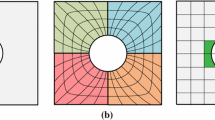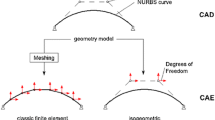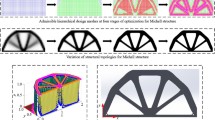Summary
A Transfinite Meshing Approach for Body-In-White Analyses Kirk Beatty and Nilanjan Mukherjee Meshing and Abstraction Group Digital Simulation Solutions Siemens PLM Software 2000 Eastman Dr., Milford, Ohio 45150 USA kirk.beatty@siemens.com, mukherjee.nilanjan@siemens.com Summary. A very wide range of finite element analyses required to design car-bodies calls for quadrilateral meshes with austere quality needs. Quadrilaterals being varying strain and non-planar, element quality, in body-inwhite analyses, is virtually impossible to measure with a single parameter. Auto-designers mostly prefer heuristic element quality metrices that catapult the need for predominantly orthogonal meshes. Transfinite or “mapped” meshing thus assumes great importance. The present investigation presents a holistic transfinite meshing approach for body-in-white analyses involving groups of tessellated faces. A new corner detection algorithm is proposed. The concept of “pseudo-edges” is introduced to cluster face edges into four logical sides. “pseudo-edge-clans” are next formed for the purpose of count propagation that does not require traditional LP solves. In the meshing process, we use 2D domain generation from a 3D tessellation at two steps. During corner determination we use a least squares conformal map with free boundaries to find boundary angles in 2D. After pseudo edges are identified, 2D domain for meshing a face is generated using a constrained rectangular boundary. In this second use of our domain generation method, we make use of a mapping type parameter which varies from conformal (angle preserving) solution to an authalic (area preserving) map. Based on practical examples, the best value for the mapping type parameter for the second domain generation step was found to be about 0.7. We present several results to illustrate our process of meshing for body-in-white analyses.
Access this chapter
Tax calculation will be finalised at checkout
Purchases are for personal use only
Preview
Unable to display preview. Download preview PDF.
Similar content being viewed by others
References
Beatty, K., Mukherjee, N.: Flattening 3d triangulations for quality surface mesh generation. In: Proceedings 17th International Meshing Roundtable, pp. 125–139 (2008)
Cabello, J.: Towards quality surface meshing. In: Proceedings 12th International Meshing Roundtable, pp. 201–213 (2003)
Faux, I.D., Pratt, M.J.: Computational Geometry for Design and Manufacture. Halsted Press, New York (1979)
Gopalsamy, S., Ross, D.H., Ito, Y., Shih, A.M.: Structured grid generation over nurbs and facetted surface patches by reparameterization. In: Proceedings 14th International Meshing Roundtable, pp. 287–300 (2005)
Mitchell, S.: Choosing corners of rectangles for mapped meshing. In: Proceedings 13th annual symposium on Computational Geometry, pp. 87–93 (1993)
Mitchell, S.: High fidelity interval assignment. In: Proceedings 6th International Meshing Roundtable, pp. 33–44 (1997)
Mukherjee, N.: High quality bi-linear transfinite meshing with interior point constraints. In: Proceedings 15th International Meshing Roundtable, pp. 309–323 (2006)
Ryskin, G., Leal, L.G.: Orthogonal mapping. Journal of Computational Physics 50, 71–100 (1983)
Tam, T.K.H., Armstrong, C.G.: Finite element mesh control by integer programming. International Journal for Numerical Methods in Engineering 36, 2581–2605 (1993)
Simple LP solve site (June 2010), http://riot.ieor.berkeley.edu/riot/Applications/SimplexDemo/Simplex.html
Vurputoor, R., Mukherjee, N., Cabello, J., Hancock, M.: A mesh morphing technique for geometrically dissimilar tesselated surfaces. In: Proceedings 15th International Meshing Roundtable, pp. 315–334 (2007)
Author information
Authors and Affiliations
Editor information
Editors and Affiliations
Rights and permissions
Copyright information
© 2010 Springer-Verlag Berlin Heidelberg
About this paper
Cite this paper
Beatty, K., Mukherjee, N. (2010). A Transfinite Meshing Approach for Body-In-White Analyses. In: Shontz, S. (eds) Proceedings of the 19th International Meshing Roundtable. Springer, Berlin, Heidelberg. https://doi.org/10.1007/978-3-642-15414-0_4
Download citation
DOI: https://doi.org/10.1007/978-3-642-15414-0_4
Publisher Name: Springer, Berlin, Heidelberg
Print ISBN: 978-3-642-15413-3
Online ISBN: 978-3-642-15414-0
eBook Packages: EngineeringEngineering (R0)




